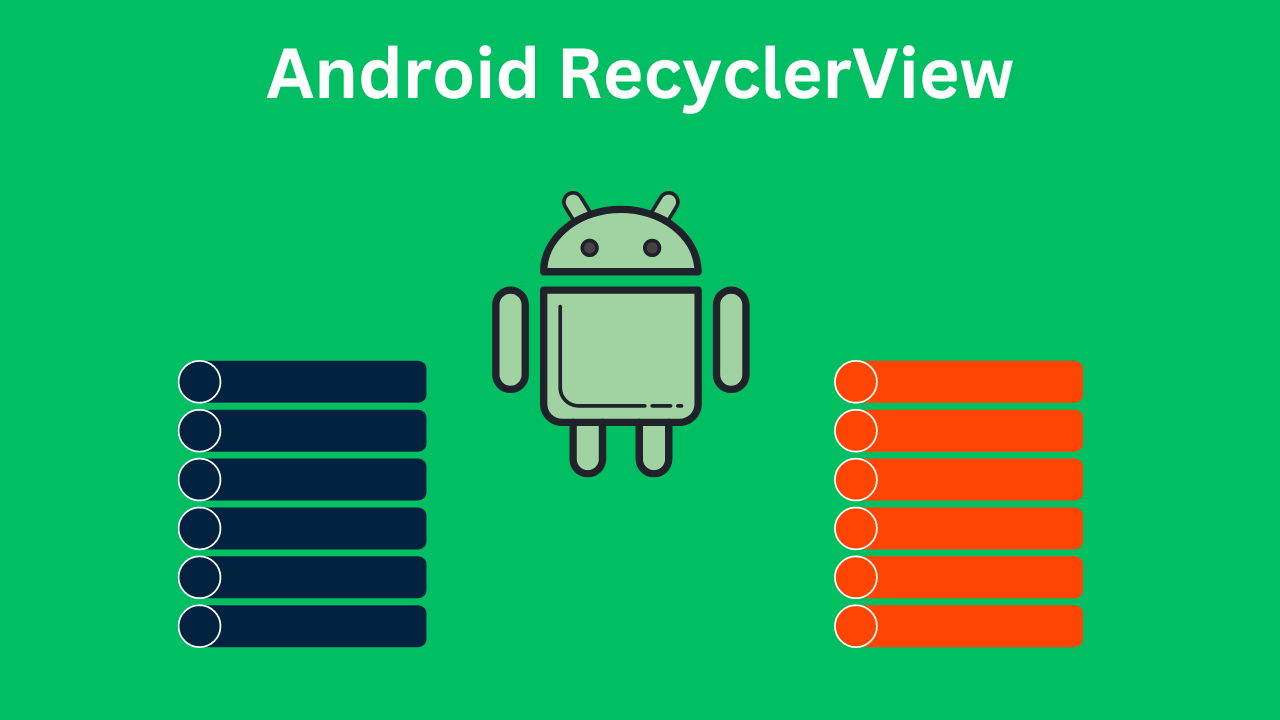RecyclerView is a more advanced and flexible version of ListView, designed to handle larger data sets more efficiently in Android applications. Let’s break down the key differences between RecyclerView and ListView, and provide a Kotlin example to illustrate how to use RecyclerView.
RecyclerView vs. ListView
Performance
- RecyclerView: More efficient in handling large data sets. It uses the ViewHolder pattern to cache views that are not visible, reducing the number of times views are created and binding data only when necessary.
- ListView: Simpler and less efficient for large data sets. Views are created and destroyed frequently as the user scrolls, leading to potential performance issues.
Flexibility
- RecyclerView: Highly customizable. It supports different layout managers (LinearLayoutManager, GridLayoutManager, StaggeredGridLayoutManager), and item animations.
- ListView: Less flexible. It has a fixed vertical scrolling mechanism and limited support for animations.
ViewHolder Pattern
- RecyclerView: Enforces the ViewHolder pattern, making it mandatory to implement and thus ensuring better performance.
- ListView: The ViewHolder pattern is optional but recommended. Developers have to implement it manually for performance benefits.
Item Decoration
- RecyclerView: Supports item decorations like dividers and margins directly via the
ItemDecorationclass. - ListView: Requires custom implementations or third-party libraries for similar decorations.
Animation
- RecyclerView: Supports built-in animations for item addition, removal, and changes.
- ListView: Limited animation support. Custom implementations are needed for complex animations.
Example of RecyclerView in Kotlin
Here is a simple example demonstrating how to use RecyclerView in Kotlin:
- Add dependencies: Make sure you have the necessary dependencies in your
build.gradlefile.
dependencies {
implementation "androidx.recyclerview:recyclerview:1.2.1"
}
- Create a layout file: Define the layout for your activity and the individual items.
activity_main.xml
<LinearLayout xmlns:android="http://schemas.android.com/apk/res/android"
xmlns:tools="http://schemas.android.com/tools"
android:layout_width="match_parent"
android:layout_height="match_parent"
android:orientation="vertical"
tools:context=".MainActivity">
<androidx.recyclerview.widget.RecyclerView
android:id="@+id/recyclerView"
android:layout_width="match_parent"
android:layout_height="match_parent"/>
</LinearLayout>
item_view.xml
<LinearLayout xmlns:android="http://schemas.android.com/apk/res/android"
android:layout_width="match_parent"
android:layout_height="wrap_content"
android:orientation="horizontal"
android:padding="16dp">
<TextView
android:id="@+id/textView"
android:layout_width="wrap_content"
android:layout_height="wrap_content"
android:textSize="18sp"/>
</LinearLayout>
3. Create a data model:
data class Item(val text: String)
4. Create an adapter:
class MyAdapter(private val itemList: List<Item>) : RecyclerView.Adapter<MyAdapter.MyViewHolder>() {
class MyViewHolder(itemView: View) : RecyclerView.ViewHolder(itemView) {
val textView: TextView = itemView.findViewById(R.id.textView)
}
override fun onCreateViewHolder(parent: ViewGroup, viewType: Int): MyViewHolder {
val view = LayoutInflater.from(parent.context).inflate(R.layout.item_view, parent, false)
return MyViewHolder(view)
}
override fun onBindViewHolder(holder: MyViewHolder, position: Int) {
val item = itemList[position]
holder.textView.text = item.text
}
override fun getItemCount() = itemList.size
}
5. Set up RecyclerView in your activity:
class MainActivity : AppCompatActivity() {
override fun onCreate(savedInstanceState: Bundle?) {
super.onCreate(savedInstanceState)
setContentView(R.layout.activity_main)
val recyclerView: RecyclerView = findViewById(R.id.recyclerView)
recyclerView.layoutManager = LinearLayoutManager(this)
val items = listOf(
Item("Item 1"),
Item("Item 2"),
Item("Item 3"),
// Add more items
)
val adapter = MyAdapter(items)
recyclerView.adapter = adapter
}
}
Summary
RecyclerView is a powerful tool for displaying lists of data in Android applications, offering better performance and more customization options compared to ListView. This example demonstrates the basic setup and usage of RecyclerView in Kotlin, highlighting its advantages and the steps to implement it effectively.

